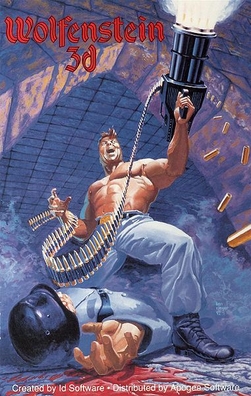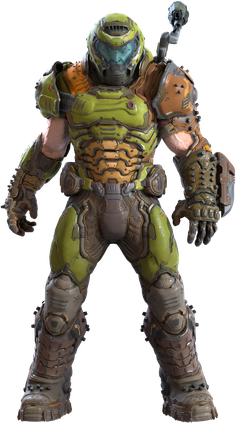
Doom is a first-person shooter game developed and published by id Software. Released on December 10, 1993, for DOS, it is the first installment in the Doom franchise. The player assumes the role of a space marine, later unofficially referred to as Doomguy, fighting through hordes of undead humans and invading demons. The game begins on the moons of Mars and finishes in hell, with the player traversing each level to find its exit or defeat its final boss. It is an early example of 3D graphics in video games, and has enemies and objects as 2D images, a technique sometimes referred to as 2.5D graphics.

Hexen: Beyond Heretic is a fantasy first-person shooter video game developed by Raven Software and published by id Software distributed through GT Interactive on October 30, 1995. It is the indirect sequel to 1994's Heretic, and the second game in Raven Software's "Serpent Riders" trilogy, which culminated with Hexen II. The title comes from the German noun Hexen, which means "witches", and/or the verb hexen, which means "to cast a spell". Game producer John Romero stated that a third, unreleased game in this series was to be called Hecatomb.

id Software LLC is an American video game developer based in Richardson, Texas. It was founded on February 1, 1991, by four members of the computer company Softdisk: programmers John Carmack and John Romero, game designer Tom Hall, and artist Adrian Carmack.

Quake is a first-person shooter game developed by id Software and published by GT Interactive. The first game in the Quake series, it was originally released for MS-DOS, Microsoft Windows, and Linux in 1996, followed by Mac OS and Sega Saturn in 1997 and Nintendo 64 in 1998. In the game, players must find their way through various maze-like, medieval environments while battling monsters using an array of weaponry. Quake takes inspiration from gothic fiction and the works of H. P. Lovecraft.

Wolfenstein 3D is a first-person shooter video game developed by id Software and published by Apogee Software and FormGen. Originally released on May 5, 1992, for DOS, it was inspired by the 1981 Muse Software video game Castle Wolfenstein, and is the third installment in the Wolfenstein series. In Wolfenstein 3D, the player assumes the role of Allied spy William "B.J." Blazkowicz during World War II as he escapes from the Nazi German prison Castle Wolfenstein and carries out a series of crucial missions against the Nazis. The player traverses each of the game's levels to find an elevator to the next level or kill a final boss, fighting Nazi soldiers, dogs, and other enemies with a knife and a variety of guns.

Alfonso John Romero is an American director, designer, programmer and developer in the video game industry. He is a co-founder of id Software and designed their early games, including Wolfenstein 3D (1992), Doom (1993), Doom II (1994), Hexen (1995) and Quake (1996). His designs and development tools, along with programming techniques developed by id Software's lead programmer, John Carmack, popularized the first-person shooter (FPS) genre. Romero is also credited with coining the multiplayer term "deathmatch".

Doom 3 is a 2004 survival horror first-person shooter video game developed by id Software and published by Activision. Doom 3 was originally released for Microsoft Windows on August 3, 2004, adapted for Linux later that year, and ported by Aspyr Media for Mac OS X in 2005. Developer Vicarious Visions ported the game to the Xbox, releasing it worldwide on April 4, 2005.

Doom II, also known as Doom II: Hell on Earth, is a first-person shooter game in the Doom franchise developed by id Software. It was released for MS-DOS in 1994 and Macintosh in 1995. Unlike the original Doom, which was initially only available through shareware and mail order, Doom II was sold in stores.
id Tech 1, also known as the Doom engine, is the game engine used in the id Software video games Doom and Doom II: Hell on Earth. It is also used in Heretic, Hexen: Beyond Heretic, Strife: Quest for the Sigil, Hacx: Twitch 'n Kill, Freedoom, and other games produced by licensees. It was created by John Carmack, with auxiliary functions written by Mike Abrash, John Romero, Dave Taylor, and Paul Radek. Originally developed on NeXT computers, it was ported to MS-DOS and compatible operating systems for Doom's initial release and was later ported to several game consoles and operating systems.

TeamTNT was a distributed group of Doom mappers, originally formed as a Doom mailing list in 1994. The team are known for creating the TNT: Evilution episode of Final Doom, as well as several free level packs and developer resources for Doom II. Their source ports, the BOOM and Boom-DM engines were used by many level designers during the height of Doom modding in the 1990s. The group was largely inactive from 2008, with their resources remaining online until the 2015 death of administrator Ty Halderman.
Doom WAD is the default format of package files for the video game Doom and its sequel Doom II: Hell on Earth, that contain sprites, levels, and game data. WAD stands for Where's All the Data? Immediately after its release in 1993, Doom attracted a sizeable following of players who created their own mods for WAD files—packages containing new levels or graphics—and played a vital part in spawning the mod-making culture which is now commonplace for first-person shooter games. Thousands of WADs have been created for Doom, ranging from single custom levels to full original games; most of these can be freely downloaded over the Internet. Several WADs have also been released commercially, and for some people the WAD-making hobby became a gateway to a professional career as a level designer.

Doom 3: Resurrection of Evil is a survival horror first-person shooter video game developed by Nerve Software and published by Activision. It was released for Microsoft Windows worldwide on April 4, 2005, as an expansion pack and sequel to Doom 3 and on October 5, 2005, for the Xbox video game console. The Xbox version does not require the original Doom 3 in order to play, and includes The Ultimate Doom, Doom II: Hell on Earth and Master Levels for Doom II. A remastered version of Resurrection of Evil was included with Doom 3: BFG Edition.
A first-person shooter engine is a video game engine specialized for simulating 3D environments for use in a first-person shooter video game. First-person refers to the view where the players see the world from the eyes of their characters. Shooter refers to games which revolve primarily around wielding firearms and killing other entities in the game world, either non-player characters or other players.
Doom, a first-person shooter game by id Software, was released in December 1993 and is considered one of the most significant and influential video games in history. Development began in November 1992, with programmers John Carmack and John Romero, artists Adrian Carmack and Kevin Cloud, and designer Tom Hall. Late in development, Hall was replaced by Sandy Petersen and programmer Dave Taylor joined. The music and sound effects were created by Bobby Prince.

Doom 64 is a first-person shooter game by Midway. It was first released for the Nintendo 64 in 1997, as the second spin-off game in the Doom series after Final Doom (1996), and the fourth game in the series overall. A remastered port was developed by Nightdive Studios and published by Bethesda Softworks for Nintendo Switch, PlayStation 4, Windows, and Xbox One in March 2020, and for Stadia in May 2020.

Doomguy is the protagonist of the Doom game series by id Software. He was created by American video game designer John Romero and was introduced as the player character in the original 1993 video game Doom. Within the Doom series, Doomguy is a demon hunter space marine dressed in green combat armor who rarely speaks onscreen, and his personality and backstory were intentionally vague to reinforce his role as a player avatar. In Doom Eternal, he is voiced by American voice actor Matthew Waterson, while Jason Kelley voices the character in that game's downloadable content The Ancient Gods: Part Two, and was portrayed by Karl Urban in the 2005 film adaptation. He has appeared in several other games developed by id Software, including Quake Champions and Quake III Arena.

Alien Breed 3D II: The Killing Grounds is a first-person shooter, the fifth game in the Alien Breed franchise, a series of science fiction-themed shooters by Team17. It was published in 1996 by Ocean Software.

id Tech is a series of separate game engines designed and developed by id Software. Prior to the presentation of the id Tech 5-based game Rage in 2011, the engines lacked official designation and as such were simply referred to as the Doom and Quake engines, from the name of the main game series the engines had been developed for. "id Tech" has been released as free software under the GNU General Public License. id Tech versions 0 to 3 were released under GPL-2.0-or-later. id Tech versions 3.5 to 4.5 were released under GPL-3.0-or-later. id Tech 5 to 7 are proprietary, with id Tech 7 currently being the latest utilized engine.

Doom is an American media franchise created by John Carmack, John Romero, Adrian Carmack, Kevin Cloud, and Tom Hall. The series usually focuses on the exploits of an unnamed space marine operating under the auspices of the Union Aerospace Corporation (UAC), who fights hordes of demons and the undead to save Earth from an apocalyptic invasion.















